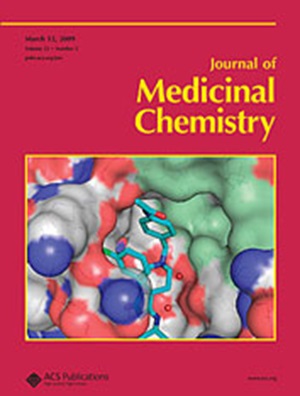Structure–Activity Relationships and Evaluation of 2-(Heteroaryl-cycloalkyl)-1H-indoles as Tauopathy Positron Emission Tomography Radiotracers
IF 6.8
1区 医学
Q1 CHEMISTRY, MEDICINAL
引用次数: 0
Abstract
Structure–activity relationship studies were performed on a library of synthesized compounds based on previously identified tau ligands. The top 13 new compounds had Ki values in the range of 5–14 nM in Alzheimer’s disease (AD), progressive supranuclear palsy (PSP), and corticobasal degeneration (CBD) post-mortem brain tissues. One of the more promising new compounds ([3H]75) bound with high affinity in AD, PSP, and CBD tissues (KD’s = 1–1.5 nM) and Pick’s disease tissue (KD = 3.8 nM). Autoradiography studies with [3H]75 demonstrated specific binding in AD, PSP, and CBD post-mortem tissues. Nonhuman primate brain PET imaging with [18F]75 demonstrated a peak standardized uptake value (SUV) of ∼5 in the cerebellum, ∼4.5 in the cortex, and ∼4 in whole brain with SUV 2-to-90 min ratios of 3.9 in whole brain, 4.9 in cortex, and 4.5 in cerebellum. Compound [18F]75 is a promising candidate for translation to human brain PET imaging studies.

求助全文
约1分钟内获得全文
求助全文
来源期刊

Journal of Medicinal Chemistry
医学-医药化学
CiteScore
4.00
自引率
11.00%
发文量
804
审稿时长
1.9 months
期刊介绍:
The Journal of Medicinal Chemistry is a prestigious biweekly peer-reviewed publication that focuses on the multifaceted field of medicinal chemistry. Since its inception in 1959 as the Journal of Medicinal and Pharmaceutical Chemistry, it has evolved to become a cornerstone in the dissemination of research findings related to the design, synthesis, and development of therapeutic agents.
The Journal of Medicinal Chemistry is recognized for its significant impact in the scientific community, as evidenced by its 2022 impact factor of 7.3. This metric reflects the journal's influence and the importance of its content in shaping the future of drug discovery and development. The journal serves as a vital resource for chemists, pharmacologists, and other researchers interested in the molecular mechanisms of drug action and the optimization of therapeutic compounds.
 求助内容:
求助内容: 应助结果提醒方式:
应助结果提醒方式:


